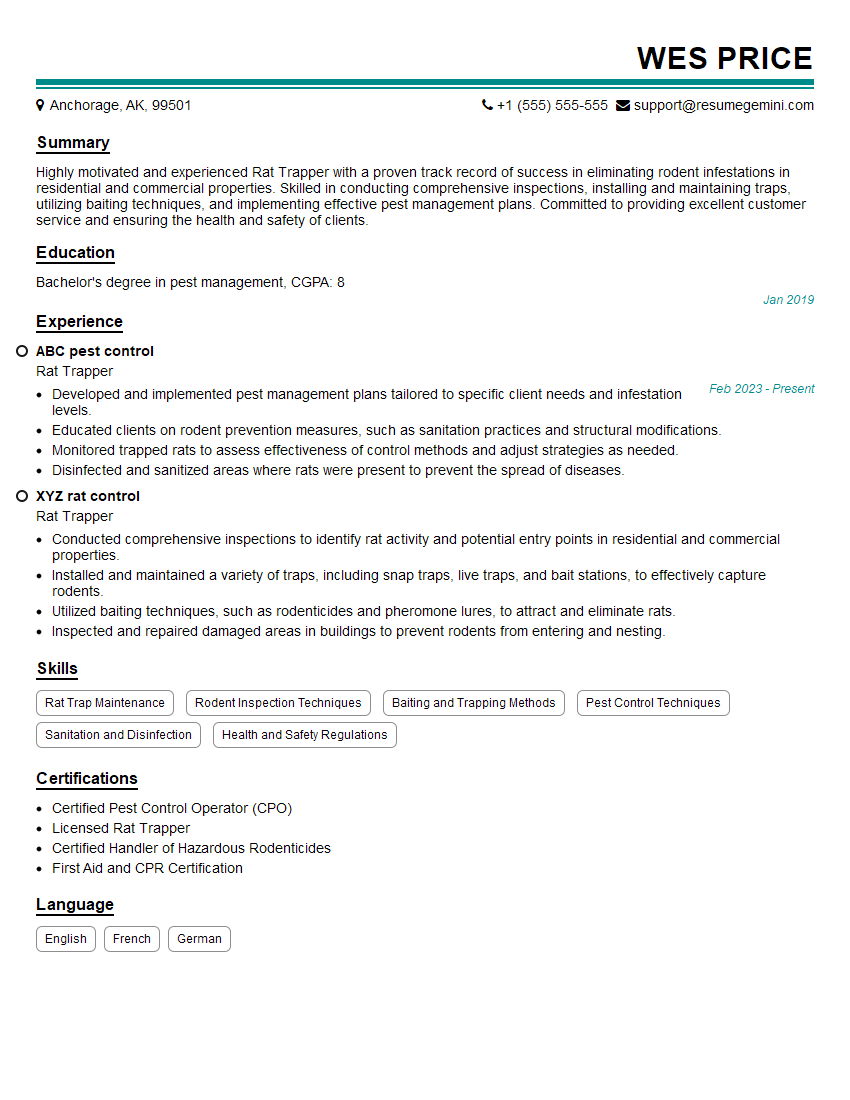Are you a seasoned Rat Trapper seeking a new career path? Discover our professionally built Rat Trapper Resume Template. This time-saving tool provides a solid foundation for your job search. Simply click “Edit Resume” to customize it with your unique experiences and achievements. Customize fonts and colors to match your personal style and increase your chances of landing your dream job. Explore more Resume Templates for additional options.

Wes Price
Rat Trapper
Summary
Highly motivated and experienced Rat Trapper with a proven track record of success in eliminating rodent infestations in residential and commercial properties. Skilled in conducting comprehensive inspections, installing and maintaining traps, utilizing baiting techniques, and implementing effective pest management plans. Committed to providing excellent customer service and ensuring the health and safety of clients.
Education
Bachelor’s degree in pest management
January 2019
Skills
- Rat Trap Maintenance
- Rodent Inspection Techniques
- Baiting and Trapping Methods
- Pest Control Techniques
- Sanitation and Disinfection
- Health and Safety Regulations
Work Experience
Rat Trapper
- Developed and implemented pest management plans tailored to specific client needs and infestation levels.
- Educated clients on rodent prevention measures, such as sanitation practices and structural modifications.
- Monitored trapped rats to assess effectiveness of control methods and adjust strategies as needed.
- Disinfected and sanitized areas where rats were present to prevent the spread of diseases.
Rat Trapper
- Conducted comprehensive inspections to identify rat activity and potential entry points in residential and commercial properties.
- Installed and maintained a variety of traps, including snap traps, live traps, and bait stations, to effectively capture rodents.
- Utilized baiting techniques, such as rodenticides and pheromone lures, to attract and eliminate rats.
- Inspected and repaired damaged areas in buildings to prevent rodents from entering and nesting.
Certificates
- Certified Pest Control Operator (CPO)
- Licensed Rat Trapper
- Certified Handler of Hazardous Rodenticides
- First Aid and CPR Certification
Languages
- English
- French
- German
Career Expert Tips:
- Select the ideal resume template to showcase your professional experience effectively.
- Master the art of resume writing to highlight your unique qualifications and achievements.
- Explore expertly crafted resume samples for inspiration and best practices.
- Build your best resume for free this new year with ResumeGemini. Enjoy exclusive discounts on ATS optimized resume templates.
How To Write Resume For Rat Trapper
- Highlight your experience and skills in rat trapping and pest management in your resume.
- Showcase your knowledge of different types of traps, baiting techniques, and pest control methods.
- Emphasize your ability to conduct thorough inspections and identify potential rodent entry points.
- Demonstrate your commitment to customer satisfaction and providing effective pest control solutions.
Essential Experience Highlights for a Strong Rat Trapper Resume
- Conduct thorough inspections to identify rat activity and potential entry points in buildings.
- Install and maintain a variety of traps, including snap traps, live traps, and bait stations, to effectively capture rodents.
- Utilize baiting techniques, such as rodenticides and pheromone lures, to attract and eliminate rats.
- Inspect and repair damaged areas in buildings to prevent rodents from entering and nesting.
- Develop and implement pest management plans tailored to specific client needs and infestation levels.
- Educate clients on rodent prevention measures, such as sanitation practices and structural modifications.
- Monitor trapped rats to assess effectiveness of control methods and adjust strategies as needed.
Frequently Asked Questions (FAQ’s) For Rat Trapper
What are the most common types of traps used for rat trapping?
The most common types of traps used for rat trapping include snap traps, live traps, and bait stations.
What are the key baiting techniques used to attract rats?
Some common baiting techniques include using food items such as peanut butter, cheese, or bacon, as well as pheromone lures that mimic the scent of female rats.
What are the potential health hazards associated with rat infestations?
Rat infestations can pose health hazards due to the diseases they carry, such as hantavirus, leptospirosis, and plague.
What are the key preventive measures to avoid rat infestations?
To prevent rat infestations, it is important to eliminate sources of food and water, seal up potential entry points, and maintain a clean and sanitary environment.
What regulations and safety precautions should be followed during rat trapping?
It is important to follow local regulations and safety precautions when handling and disposing of trapped rats, including wearing protective gear and using proper disposal methods.
What additional skills and certifications are beneficial for rat trappers?
Additional skills and certifications that can benefit rat trappers include knowledge of pest biology, experience in using specialized equipment, and certification in pest control techniques.